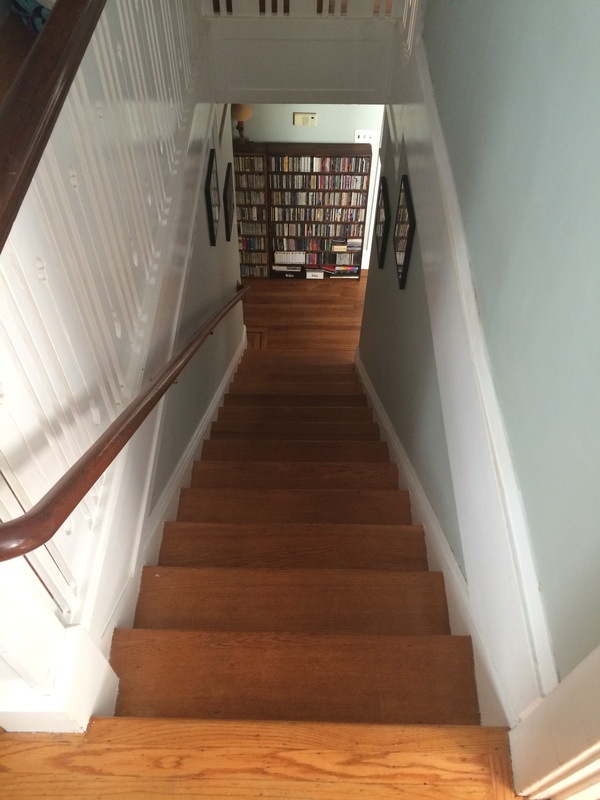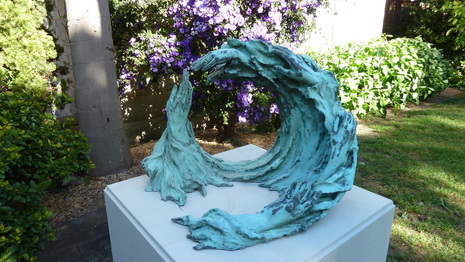n
I usually don’t make New Year’s resolutions. In the past I’ve found that any resolutions I make are quickly forgotten causing needless pseudo-guilt and moments of almost feeling bad. But one thing I am reminded of every New Year’s is how quickly time passes and more importantly, how it seems to be passing faster as I get older.
Several years ago I had a huge AHA moment in regards to time and how I experience time passing. It happened on a Sunday afternoon at home during the winter when the light was just fading. I’d been putting laundry away upstairs and was headed downstairs to the kitchen in fast motion as usual. But something made me stop at the top of the stairs. Mind you, this was the same staircase I’d gone up and down hundreds—no make that thousands–of times during the years we’d lived in the house. But something in that particular moment made me pause. This is what I saw:
Immediately—and this shows you how my mind works—I asked myself how I represented time as a little kid when every moment I wasn’t fully engaged seemed like an eternity. A memory quickly came up. It was the Fourth of July when I was five years old. My family was spending the Fourth with my Uncle J.R. and his family on their farm in South Texas. In the memory I was outside in the front yard swinging away on a swing hung from a tree branch, saying the phrase “Fourth of July” out loud over and over in every possible way, from various cartoon voices to emphasizing different syllables in each of the words. It was mid-afternoon in the heat and high humidity of the sub-tropical South Texas climate. No one else was around because everyone had the good sense to be inside in air conditioning.
With the second image an internal question came quickly; how did I experience time passing differently in that memory as a little kid? The answer came in a flash. In the memory of being on the swing time was like a light, more precisely an orange glow that surrounded me not unlike the light in the Maxfield Parrish painting above. There’s one more thing. The orange glow that surrounded me (an interesting thought all by itself) was moving slowly and gently backwards in a huge rotating spin; backwards and not forwards like the staircase experience above. The next thought in this sequence also followed quickly. Was the way to slow down my sense of time passing to stop the crazy tumbling forward spinning feeling and reverse it, making the spin backwards in a huge, slow-moving orange glow? While this may sound completely alien nation, it worked instantly for me. I’ve tried it innumerable times since and it always works. Any time I feel rushed, anxious, or late, I bring the internal motion that I sense as time rushing out of control to a complete halt and then expand it, make it orange in color, gentle in feeling, and start spinning it backwards slowly. It always works.
http://www.timgaiser.com/blog/game-day-skills-part-one-the-dynamics-of-spin
Spin Dynamics is based on the idea that everything in the universe—from galaxies and planets all the way down to sub-atomic particles like quarks and mesons—spins. The same holds true for our feelings. They’re not static in our bodies but move and have direction and spin. The Spin Dynamics strategy simply has us becoming aware of the how feelings within us move. If the feelings are positive, how to amp them up by spinning them faster; or if they’re negative feelings, how to neutralize them by reversing the spin.
Back to how we experience time passing. What about you? How do you experience time, especially when it seems to be out of control? Does it spin forward? Backward? Clockwise or counter-clockwise? Does it have any sort of color? If so, is the color dark or light? What happens if you slow the spin down, stop it, and reverse the spin? What happens also if you change the color and make it lighter? Does it seem like time moves more slowly? Experiment!
I do have a New Year’s resolution after all; to be more mindful of time and how I experience it passing. And any time I feel rushed or like time is moving too quickly for comfort I now remember to slow the feeling down and start moving it backwards.
Cheers to all!
nn


